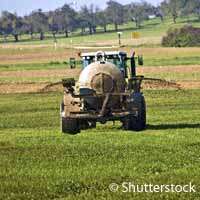Making manure work for agriculture

Livestock manure represents a valuable resource in the agriculture sector. As fertilizer it is a source of nitrogen, phosphorous and organic matter, all crucial for the sustainability of European farming.
But manure can also have negative impacts on the environment, depending on how it is used. Manure can contaminate surface and groundwater, for example, or cause air pollution in the form of malodorous emissions and greenhouse gases. And, after repeated applications of manure, soil can eventually suffer nutrient imbalances and an accumulation of heavy metals and antibiotics.
The EU project BIOECOSIM ('An innovative bio-economy solution to valorise livestock manure into a range of stabilised soil improving materials for environmental sustainability and economic benefit for European agriculture') aims to develop and demonstrate a resource- and energy-efficient pilot plant for the conversion of livestock manure into safe and stable materials that can be easily handled, transported, and applied.
Led by researchers at Fraunhofer-Gesellschaft zur Förderung der angewandten Forschung e.V., BIOECOSIM will produce a cost-effective system combining a number of innovative technologies. The team is using an integrated approach and business model that has wide application in the agriculture sectors of all EU countries.
"The BIOECOSIM's solution involves the advancement of existing best available technologies for the treatment of livestock manure," says Fraunhofer's Sukhanes Laopeamthong. "Part of the energy required by our new process will be generated through the combustion of syngas (synthetic gas), which is derived from the manure itself, thus reducing the need for fossil fuels.
He adds: "Water reclaimed from manure will be utilised for livestock production and irrigation, while resulting soil-improving materials will be evaluated in agronomic trials with three representative plant species and three different soil types. Finally, the sustainability of our approach will be validated against ISO standards."
Laopeamthong says the new process will provide a solution to problem of nutrient surplus in regions with high livestock densities. "This will benefit livestock farmers, allowing them to generate income from the sale of soil-improving products and electricity generated from syngas, instead of paying the high costs for disposing of manure," he says.
He adds: "At the same time, crop farmers will benefit because they will be less dependent on synthetic, non-renewable and imported fertiliser to maintain or enhance their yields."
BIOECOSIM's partners believe that once small agricultural entrepreneurs put their results into practice on a trans-regional basis, new economic opportunities will be generated.
"Ultimately, over 11 million people employed in the EU's agriculture sector could be affected by this outcome," he says. "The project will guarantee full sustainability of the proposed approach by both economic and environmental measures that can be replicated across Europe in the medium-term, taking us closer to a more resource-efficient and circular economy."
BIOECOSIM has been awarded EUR 3.8 million in EU funding and will run through September 2016.
More information: www.bioecosim.eu/index.html
Provided by CORDIS
















